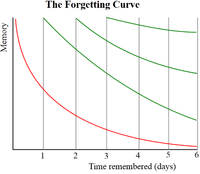Brain
(Work-in-progress save) |
|||
| Line 4: | Line 4: | ||
}} | }} | ||
| − | The '''brain''' is the primary organic data storage medium of animals with central nervous systems. | + | The '''brain''' is the primary organic data storage medium of animals with central nervous systems. The brain is comprised of neurons, cells that process and transmit information through electrochemical signals. Signals move between neurons via specialized connections with other cells called synapses. Neurons connect to each other to form neural networks which store long-term memories. |
== Data persistence == | == Data persistence == | ||
| − | [[File:forgettingcurve.png|200px|thumb|right|The exponential rate of forgetting for human brains, as | + | [[File:forgettingcurve.png|200px|thumb|right|The exponential rate of forgetting for human brains, as modeled by Hermann Ebbinghaus.]] |
| − | Short-term memory is volatile and stored as patterns of electrical activity. During sleep, short-term memories are consolidated into non-volatile long-term memory in the form of neural connections. | + | Short-term memory is volatile and is stored as patterns of electrical activity. During sleep, short-term memories are consolidated into non-volatile long-term memory in the form of neural connections. Weak short- and long-term memories that are considered unimportant are automatically deleted to save space. |
| − | + | Memories stored in brains are non-persistent and subject to being forgotten. The rate of forgetting is determined by the time interval since last memory recall, vividness and impact of the imprinted memory, and health state and age of the brain. | |
== Links == | == Links == | ||
| + | *[http://en.wikipedia.org/wiki/Exceptional_memory Enhancing data retention] | ||
| + | *[http://en.wikipedia.org/wiki/Forgetting#Seven_types_of_forgetting The processes of data deletion] | ||
| + | *[http://en.wikipedia.org/wiki/Engram_%28neuropsychology%29 Recovering deleted data (experimental)] | ||
| + | *[http://en.wikipedia.org/wiki/Evolution_of_nervous_systems Evolution of the brain] | ||
| + | *[http://en.wikipedia.org/wiki/Brain Brain (Wikipedia)] | ||
Revision as of 07:50, 26 November 2013
The brain is the primary organic data storage medium of animals with central nervous systems. The brain is comprised of neurons, cells that process and transmit information through electrochemical signals. Signals move between neurons via specialized connections with other cells called synapses. Neurons connect to each other to form neural networks which store long-term memories.
Data persistence
Short-term memory is volatile and is stored as patterns of electrical activity. During sleep, short-term memories are consolidated into non-volatile long-term memory in the form of neural connections. Weak short- and long-term memories that are considered unimportant are automatically deleted to save space.
Memories stored in brains are non-persistent and subject to being forgotten. The rate of forgetting is determined by the time interval since last memory recall, vividness and impact of the imprinted memory, and health state and age of the brain.
